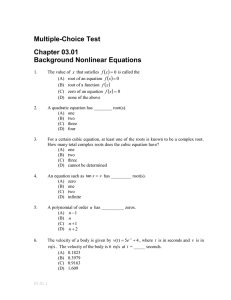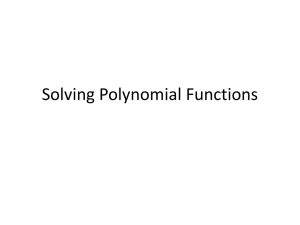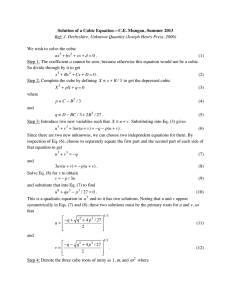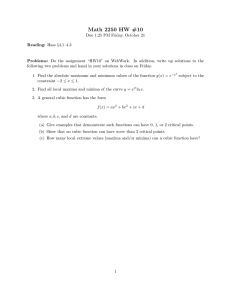1 Shapes of Cubic Functions
advertisement
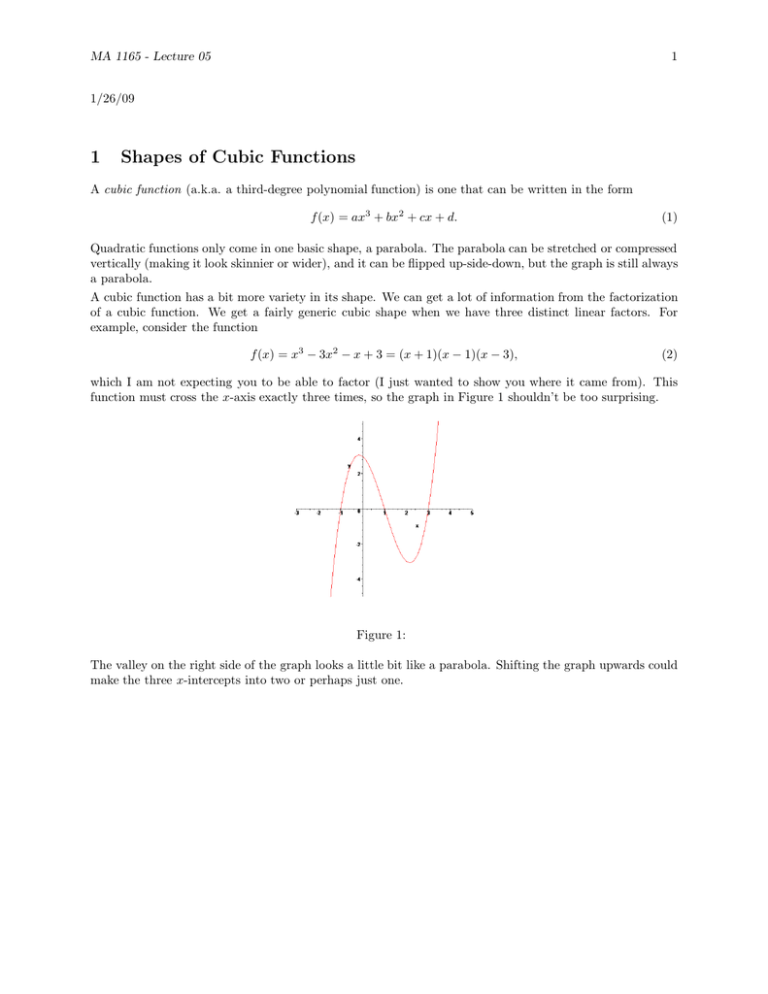
1 MA 1165 - Lecture 05 1/26/09 1 Shapes of Cubic Functions A cubic function (a.k.a. a third-degree polynomial function) is one that can be written in the form f(x) = ax3 + bx2 + cx + d. (1) Quadratic functions only come in one basic shape, a parabola. The parabola can be stretched or compressed vertically (making it look skinnier or wider), and it can be flipped up-side-down, but the graph is still always a parabola. A cubic function has a bit more variety in its shape. We can get a lot of information from the factorization of a cubic function. We get a fairly generic cubic shape when we have three distinct linear factors. For example, consider the function f(x) = x3 − 3x2 − x + 3 = (x + 1)(x − 1)(x − 3), (2) which I am not expecting you to be able to factor (I just wanted to show you where it came from). This function must cross the x-axis exactly three times, so the graph in Figure 1 shouldn’t be too surprising. Figure 1: The valley on the right side of the graph looks a little bit like a parabola. Shifting the graph upwards could make the three x-intercepts into two or perhaps just one. 2 1 SHAPES OF CUBIC FUNCTIONS For example, if we had a function that factored like g(x) = (x + 1)(x − 2)2 , (3) the graph would look like the one in Figure 2. Figure 2: If a function factored into a linear factor and a quadratic factor that was not factorable like h(x) = (x + 1)(x2 − 4x + 5), (4) then the graph would look like the one in Figure 3. Figure 3: One way of telling that a quadratic is not factorable is to complete the square. In this last example, we would get x2 − 4x + 5 = x2 − 4x + 4 + 5 − 4 = (x − 2)2 + 1. The squared part is going to be zero or bigger, and then we’re adding one. This must be positive, and we can see this in the graph. 3 1 SHAPES OF CUBIC FUNCTIONS 1.1 Quiz 05A In each of the following, find a cubic function with the given properties. 1. Has x-intercepts x = −2, 3, 7, and has a graph like the one in Figure 4. (a) f(x) = (x − 2)(x − 3)(x − 7) (d) f(x) = (x + 2)(x + 3)(x + 7) (b) f(x) = (x + 2)(x − 3)(x − 7) (e) none of these (c) f(x) = (x − 2)(x + 3)(x + 7) Figure 4: 2. Has x-intercepts x = −1, 1, and has a graph that looks like the one in Figure 5. (a) f(x) = (x − 1)2 (x + 1) (b) f(x) = (x + 1)(x − 1)2 2 (x + 1) (x − 1) (e) none of these Figure 5: (c) f(x) = (x − 1)(x + 1)2 (d) f(x) = 4 1 SHAPES OF CUBIC FUNCTIONS So far, however, the basic shapes we’ve seen have been pretty similar. The graphs have gone to −∞ on the left, to +∞ on the right, and there is a hill and a valley in the middle. The other basic shapes we’ll see occur when the three factors line up at the same x. For example, if we get three linear factors that are exactly the same, the hill and the valley come together. This can be seen in the function j(x) = (x − 2)3 . (5) Here the graph looks like the one in Figure 6. Figure 6: The last basic shape comes when we have a quadratic factor that doesn’t factor, and it lines up with a linear factor. For example, the quadratic expression x2 − 4x + 5 will try to give us a valley above x = 2 as in the function h above and Figure 3. If this lines up with the linear factor (x − 2), which gives us a root at x = 2, we get a graph that looks like the one in Figure 7. k(x) = (x − 2)(x2 − 4x + 5). (6) Figure 7: Notice the difference between the graphs in Figures 6 and 7. The graph in Figure 6 becomes completely horizontal at x = 2, while the graph in Figure 7 just does a little wiggle. As before, we can stretch one of the graphs above by multiplying by a number bigger than 1. Multiplying by a number smaller than one will compress the graph, and a negative number will flip everything up-side-down. 5 1 SHAPES OF CUBIC FUNCTIONS 1.2 Quiz 05B Find a cubic function that satisfies the given properties. 1. Find a cubic function that has a root at x = −2 and looks like Figure 8. (a) f(x) = (x + 2)3 (e) none of these (b) f(x) = (x − 2)3 (c) f(x) = (x + 2)2 (x − 2) (d) f(x) = (x − 2)2 (x + 2) Figure 8: 2. Find a cubic function that has roots at x = 0 and looks like Figure 9 (a) f(x) = x2 (x − 1) these (b) f(x) = x3 (c) f(x) = x(x2 + 1) Figure 9: (d) f(x) = x(x + 1)2 (e) none of 6 2 HOMEWORK 05 3. Find a cubic function that has roots at x = −1, 1, 3, and has a graph that looks like Figure 10. (a) f(x) = (x + 1)(x − 1)(x − 3) (b) f(x) = (x − 1)(x + 1)(x + 3) (d) f(x) = (−1)(x − 1)(x + 1)(x + 3) (e) none of these (c) f(x) = (−1)(x + 1)(x − 1)(x − 3) Figure 10: 2 Homework 05 Find a cubic function that satisfies the following conditions. 1. Has roots x = −3, −2, 2. (a) f(x) = (x − 3)(x − 2)(x + 2) (d) f(x) = (x + 3)(x + 2)(x − 2) 2. (b) f(x) = (x + 3)(x + 2)(x + 2) (e) none of these Has roots x = 0, 1, 2. (a) f(x) = (x + 1)(x + 2) (b) f(x) = x(x − 1)(x − 2) (x − 1)(x − 2) (e) none of these 3. (c) f(x) = (x − 3)(x − 2)(x − 2) (c) f(x) = x(x + 1)(x + 2) (d) f(x) = Has roots x = −2, 2, and looks like Figure 11. (a) f(x) = −(x + 2)(x − 2)2 (b) f(x) = (x + 2)(x − 2)2 2 f(x) = (x + 2) (x − 2) (e) none of these Figure 11: (c) f(x) = −(x + 2)2 (x − 2) (d) 7 2 HOMEWORK 05 4. Has roots x = −2, 2, and looks like Figure 12. (a) f(x) = (x + 2)2 (x − 2) (b) f(x) = −(x + 2)(x − 2)2 f(x) = −(x + 2)2 (x − 2) (e) none of these (c) f(x) = (x + 2)(x − 2)2 (d) (c) f(x) = (x − 2)(x2 − 4x + 5) (d) Figure 12: 5. Has roots x = −2, and looks like Figure 13. (a) f(x) = (x − 2)3 (b) f(x) = (x + 2)(x2 + 4x + 5) 3 f(x) = (x + 2) (e) none of these Figure 13:
